
What do you need to know about LED parking lot lights?
How do you illuminate a parking lot with LED parking lot lights? There is a lot to know. Your parking lot requires enough lighting for safe egress, and the light provided must be somewhat evenly distributed. To control ongoing expense, the light fixtures should require minimal to no maintenance and be energy efficient. The LED parking lot lights need some type of controls to only light the parking lot when required. Also, depending on where your parking lot is located, your parking lot lighting may need to meet local lighting ordinances. To achieve all your objectives and the requirements let’s get into the details.
Today the only option to go with is LED. Compared with HID parking lot lighting, LED parking lot lighting is more energy efficient typically reducing energy use by 70%. LED has 80+ color rendering, compared with 60+ CRI for MH and 20+ CRI for HPS. Using advanced optics, LED has superior light distribution. Also LED lights have a long life and require low to no maintenance,
What are the benefits of LED Parking lot lights?
- Safety and Security – A requirement for all types of businesses is for customers and employees to not only feel safe, but to be safe. LED parking lot lights provide better lighting that stays on.
- Light Distribution – LED parking lot lights provide better light distribution and more even light. The light under the fixture is less bright and the light is more broadly distributed for less dark areas.
- Color Rendering – LED parking lot lights have superior color rendering typically exceeding 80 CRI, compared with HID that has a CRI of between 20 and 63.
- Reduced Energy Consumption – More light doesn’t need to come with increased energy expense. LED parking lot lights provide equal or more light while using far less watts. Less wattage reduces peak demand charges and overall energy use for dramatic savings.
- Maintenance Cost – When a parking light goes out, to provide safe egress it needs to be fixed ASAP. Bringing in a lift truck to repair lights on poles gets expensive. LED parking lot lights do not need replacement bulbs and drivers do not break down as fast as HID ballasts. With LDED parking lot lights the lights stay on, and maintenance costs drop to close to zero.
- Instant on / Instant off – LED parking lot lights can turn on and off in an instant, as compared with HID which requires warm up and reset time. Instant on facilitates the use of occupancy controls, that provide additional energy savings. Why have the lights on if nobody is there?
- Dimmable – Most LED parking lot lights are now dimmable. This isn’t to create mood lighting like in your favorite Italian restaurant. Dimming facilitates controls that reduces the energy used and the amount of light emitted when nobody is around, while leaving some light on.
What are the different types of LED Parking lights?
LED parking lot lights come in different styles. While in some cases this may be to make an architectural statement or to meet community styling, in many other cases there are different types of LED parking lot lighting to meet different requirements.
Directed Area Lights
While mostly a relic from past applications of HID lighting, directed area lights are mounted on poles of the sides of buildings and are aimed to where you want the light to go, similar to aiming a sports light.
- Benefits
- Fewer poles and if in a freight yard or loading dock area, poles do not get in the way
- Reduced points of light mean less lights to purchase
- Makes for a good one-for-one solution when replacing legacy HID fixtures
- Negatives
- Significant light trespass
- Lots of glare
- Not full cutoff or dark sky compliant
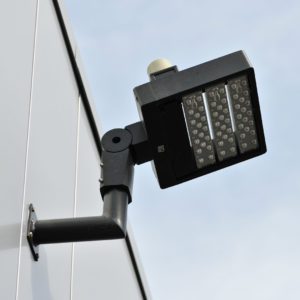
Bollard Lights
Bollard lights are used to light walkways, to illuminate parking lots and to brighten darker areas of parking lots. They are a preferred lighting source where lights on poles or lights with a mounting height of over 8 feet are not permitted.
- Benefits
- Low cost per unit
- Can be built with shields so no light is emitted on one side
- Defines guest walkways in parking lots
- Negatives
- Light is less broadly distributed as compared with lights on poles
- Cars parked close to bollard lights will block the light distributed
- Light can be reduced by deep snow covering the lights
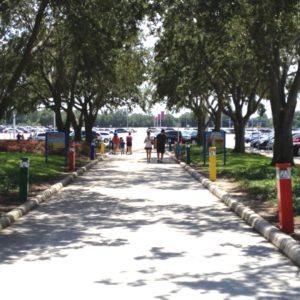
Pole mounted area lights
These are the most ubiquitous type of LED parking lot lights. They are typically mounted on poles 12’ to 30’ high, with between 1 and 4 mounted to a pole.
- Benefits
- Full cutoff and can be dark sky compliant
- Optics can be set to direct the light and minimize light trespass
- Mass produced and bough in quantity to minimize cost per unit
- Negatives
- Lacks the character of stylized light fixtures
- Light is depending on optics is emitted forward and to the sides, but not 360°
- Becomes less cost effective as the pole height is reduced
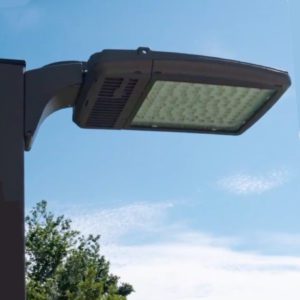
Post Top Lights
With stylized heads to meet most design applications, post top lights are a more decorative way to light a parking lot. They provide effective light subject to wattage at mounting heights of 8’ to 30’.
- Benefits
- Many styles of poles and fixtures available
- Light is emitted 360° so one light can light all sides of the pole
- Most are full cutoff and can be made to be dark sky compliant
- Negatives
- Lacks the character of stylized light fixtures
- Light is depending on optics is emitted forward and to the sides, but not 360°
- Becomes less cost effective as the pole height is reduced

Column Lights
Frequently found is the bollard light category, LED column lights are decorative light fixtures that range between 8’ and 12’ and emit low but even light over a reasonably broad area
- Benefits
- Provide light over a broad area while being under 12’ tall
- Highly stylized for a more modern appeal
- Some column lights can be full cutoff
- Negatives
- More expensive than other types of parking lot lighting
- Many styles are not full cutoff
- Less light and light distribution than most other LED parking lot lights

What are the replacement wattages for LED Parking Lot Lights?
For parking lots currently illuminated with MH or HPS, one for one replacement is frequently the quickest and easiest option. While one for one replacements can and should be calculated in every case, here is a brief outline for conversion from HID to LED parking lot light fixtures.
- 1500w MH or HPS – Use LED of approximately 450 watts
- 1000w MH or HPS – Use LED of approximately 300 watts
- 400w MH or HPS – Use LED of approximately 150 watts
- 250w MH or HPS – Use LED of approximately 100 watts
To discuss conversion from MH or HPS to LED call 800.460.9925
Click to read more about one-for-one replacement of legacy parking lot lights
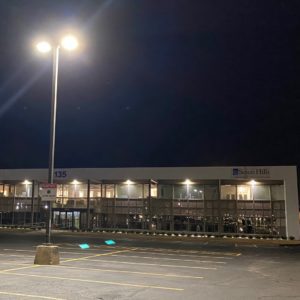
How do I space out new LED parking lot lights?
Spacing of LED parking lot lights is a function of the mounting height of the fixture and the required or preferred lumens on the ground. It also depends on the use of the parking lot. For example, if the parking lot is for passenger cars the spacing would be different than a parking for trucks where the poles would need to be far apart so the trucks could turn and back up. The following information is a primer for thought.
- 15’ to 20’ Mounting Height 20’ to 30’ spacing 12,000 to 18,000 lumens
- 20’ to 25’ Mounting Height 30’ to 40’ spacing 20,000 to 30,000 lumens
- 25’ to 35’ Mounting Height 40’ to 50’ spacing 30,000 to 70,000 lumens
While this provides a rough idea, an Access Fixtures Lighting Specialist will be able to better determine the appropriate LED light and spacing for your parking lot. He or she may also recommend a photometric study to more precisely determine the correct fixtures to use and to get the required of preferred illumination. Call 800.460.9925 to speak with a lighting specialist or send an inquiry by clicking here.
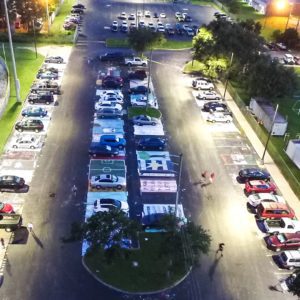
What are parking LED parking lot light mounting heights?
The mounting height for LED parking lot lights is determined by two primary factors, local ordinance and/or required spacing between the pole and the area over which the light needs to be distributed.
Mounting height of 8’ to 30’
Many communities have ordinances that influence the height, design, and layout of your parking lighting. Just about every community specifies the maximum mounting height of parking lot lights. The maximum mounting height typically ranges from 8’ to 30’. This is a broad range and naturally there are exceptions. Until you know your local community’s requirements, you can’t design your parking lot lighting. Other than swapping existing HID parking lot fixtures one-for-one, do not proceed with changing the lighting until you know the local ordinances.
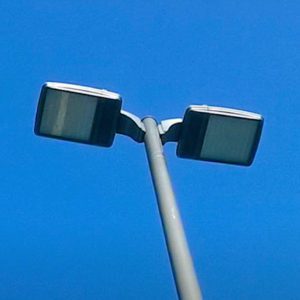
Mounting height of 35’ to 70’
Some parking lots require the lights to be mounted quite high and the poles to be very far apart. This are typically commercial applications such as a massive surface parking lot. an area where trucks will be moving around, or a freight terminal lot. In any of these examples, the light poles need to be far apart, so the light is distributed, glare is reduced, shadows are minimized and so trucks came maneuver. This lighting can be achieved by either aiming the light across the parking lot or by using the appropriate LED parking lights in full cut off or even dark sky compliant. The LED parking lot lights used for these applications are higher wattage than at lower heights, but with the correct optics and positioning, all functional objectives can be achieved.
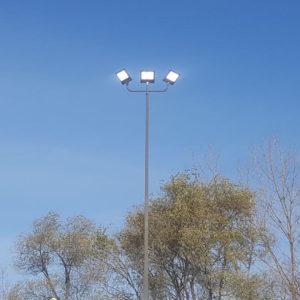
To find out further information about parking lot lighting or large area parking lot lighting speak with an Access Fixtures lighting specialist. Call 800. 468.9924 or click here.
Which Kelvin Color to Choose for LED Parking Lot Lights?
LED parking lot lights have the added benefit of being able to select your preferred Kelvin. While Metal Halide was 4300K and HPS was about 2200K, now you can select the appropriate Kelvin. Many companies and property managers opt to match the community street lighting. While most applications can use either 3000K or 4000K, these are the current primary choices.
- 590 nm – Amber colored light that is used to protect wildlife and sea turtle habitat
- 2200K – Used to keep maintain the character of early gaslight or to replicate HPS light
- 3000K – Warm light that as of 2022 meets Dark Sky regulations in most areas
- 4000K – White light that isn’t to white to be blueish white
- 5000K – Blueish white light that was common due to added energy efficiency
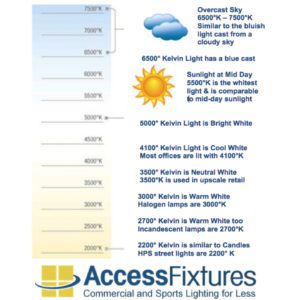
Want more advice about which Kelvin to select for your surface parking lot lighting? Click here.
What are parking lot lighting controls?
Parking lot lighting controls are used to limit the time that the lights are to when the lights are needed. Limiting the time on reduces energy use and extends the life of the parking lot light. This is a brief list of the different devices to control the LED lights in parking lots.
- Manual Switches – With a manual control you or someone you work with turns the light switch on and off. Obviously this is not an effective means of controlling lights as the lights will either not be on when you need them or the lights will be left on when you don’t need them on.
- Mechanical Time Clocks – Mechanical time clocks are analog or “old school” and straightforward to use. A dial has times listed and using a dog ear located at the on time and the off time turn s the parking lot lights on and off.
- Digital Time Clocks – Digital time clocks are the electronic version of a time clock. They frequently have more options such as 7-day settings, and may even be Internet addressable, but they are more expensive and more complicated to use.
- Photocells – Photocells can be installed on the power line going to a group of parking lot lights or installed on each fixture. Either way, photocells turn the lights on when it gets dark and turns the lights off when daylight returns.
- Occupancy Sensors – Occupancy sensors can turn the lights on for a predetermined amount of time when someone is present and when there is nobody around turn the lights off.
- Bi-Level Controls – Similar to basic occupancy sensors, when nobody is around, bi-level controls can turn the parking lot lights down to a predetermined level, but not off. That way the lot still appears open, but the energy being used is significantly reduced.
Click to read more about LED lighting controls for parking lots.
Speak with an Access Fixtures Lighting Specialist. Call 800.468.9925
What about local parking lot lighting ordinances?
Most cities and towns have lighting ordinances or parking lots. Lighting ordinances are basically laws that determine what lights can be used, how they can be used, where they can be used, how much energy is used, and how the lights may impact the local environment. While one-for-one replacement may be permitted in your community, you should always check the lighting ordinances before replacing existing parking lot lights or installing new parking lot lighting. Parking lot lighting ordinances will commonly address Max/Min ratio, mounting height, light trespass, full cut-off and/or dark sky requirements, a even maximum lumens possible on the surface of the lot.
Click this link for a more in-depth review of parking light lighting ordinances.
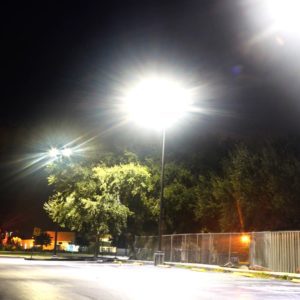
Can someone make a Parking Lot Lighting plan for my lot?
Yes. Access Fixtures lighting specialists and lighting engineers will be able to develop a parking lot lighting plan that meets your requirements and conforms to the local lighting ordinances. They start with a layout of your parking lot plan, preferably in dwg format, and a copy of your local lighting ordinances. Then based on your design and style preferences, the will use computer modeling known as a photometric study to model how the lights specified will distribute the light emitted. Adjustments are made until the specifications meet the style aesthetics, safety requirements, and local ordinances.
Click here to learn more about photometric studies.
Click to contact an Access Fixtures lighting specialist or call 800.468.9925 now.
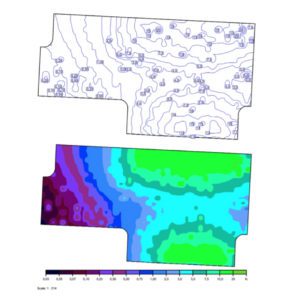
Light Pole Resources
Download Outdoor Light Pole Brochure PDF.
Download Wind Speed Map for ASCE 7-10.
Learn more about Light Pole Vibration Guidelines and Fixes.
Learn more about Aluminum Light Poles.
Learn more about Steel Light Poles.
